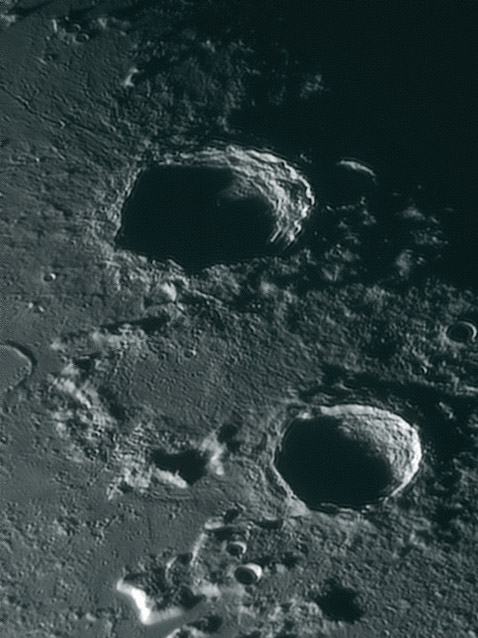
image by Ed Lomeli, Sacramento, CA
Aristoteles (top) and Eudoxus are two relatively fresh craters on the northern edge of the Caucasus Mountains. The curved, bright-edged and relatively flat-topped mountain near bottom left is typical of many of the Caucasus mountains, but the arc of peaks between Aristoteles and Eudoxus - looking like a fake Alexander - has a different character. They are rounder, softer and older looking, but too big to be part of the Imbrium ejecta that surrounds the Alpine Valley. If we want to understand every bit of lunar landscape we should have an interpretation for these hills that Ed’s image shows in their best possible light. I suppose, without much conviction, that the hills are either an odd looking extension of the Caucasus or all that is left of an old crater. As for being old, which do you think is older, Aristoteles or Eudoxus? Aristoteles has a wonderful field of alined secondary craters to its north, but not many to the south. Back in the early 70s the USGS mapped Aristoteles as Eratosthenian and Eudoxus as Copernican. Later, detailed counts of small craters superposed on both large craters confirmed that Eudoxus is younger, but not by much. I still have a hard time accepting that relative age sequence; I suppose that the Eudoxus ejecta blanket has covered the secondaries of Aristoteles. I really take it personally when the Moon isn’t the way I think it is!
Technical Details:
January 9, 2007, 12:26:39 to 12:29:00 UT. Celestron 9.25 + DMK 21BF04 mono camera + 2X Televue barlow + Baader IR-Pass filter. And a freezing morning.
Related Links:
Rükl charts 5 & 13
Another view
Yesterday's LPOD: A New Chu
Tomorrow's LPOD: Spectro-Selenography
COMMENTS?
Register, Log in, and join in the comments.



